[ad_1]
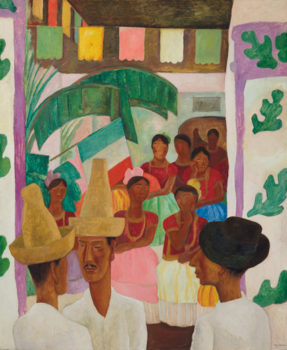
Diego Rivera, The Rivals, 1931, oil on canvas, sold for $9.76 million.
CHRISTIE’S IMAGES LTD. 2018
Last night in a jam-packed salesroom at Christie’s in Rockefeller Center in Midtown Manhattan, a sale of 19th- and 20th-century art from the collection of Peggy and David Rockefeller brought $646.1 million. Earlier this evening the second major Rockefeller auction, this one devoted to work from the Americas, brought in $106.9 million for 41 lots, roughly the same number as last night—the highest amount ever brought in for a sale of American art, according to Christies.
Tonight’s sale was—relatively speaking—a more modest and subdued affair. Christie’s had removed a few rows of seats since last night, and perhaps a quarter of them were empty when the room was called to order a minute after 7 p.m. Only two pieces sold for more than $10 million (last night ten sold for more than $15 million). That $106.9 million is less than what the top lot earned yesterday, when Picasso’s 1905 Fillette à la corbeille fleurie made $115.1 million.
Nevertheless, some exciting battles were fought and a few new market records were set, most notably for Diego Rivera, whose brightly colored scene The Rivals (1931) sold for $9.76 million to a telephone bidder working with Conor Jordan, deputy chairman of Impressionist and modern art at Christie’s, after just a few minutes of bidding. That handily trouncing its high estimate of $7 million and also demolished the previous record for a Rivera at auction, which was set when $3.08 million was paid for Baile en Tehuantepec (1928), sold by IBM at Sotheby’s in New York in May 1995.
(Adjusted for inflation, that previous record comes to about $5.05 million in today’s dollars. The top mark at auction when accounting for inflation was made with a 1942 Rivera, Vendedora de Flores, sold at Christie’s in New York in November 1991 for $2.97 million, which in today’s dollars would be about $5.38 million.)
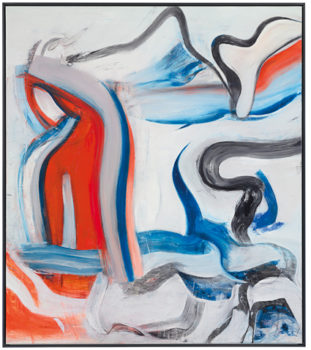
Willem de Kooning, Untitled XIX, 1982, oil and charcoal on canvas, sold for $14.3 million.
CHRISTIE’S IMAGES LTD. 2018
Tonight’s $9.76 million Rivera figure also surpassed the highest price ever paid for a work by a Latin American artist at auction, which was previously held by a 1939 Frida Kahlo painting that sold for $8 million at Christie’s in 2016. (Works have gone for higher prices through private sales, however.)
“It’s been a long-time coming,” Virgilio Garza, Christie’s head of Latin American Art, said of the new high mark, and now Frida and Diego are finally neck-in-neck with their auction records.” Both artists have had their auction records set at a Christie’s auction, he noted proudly.
As with many of the works on offer this week, the Rockefellers’ relationship to The Rivals added to the allure of the work. It had been commissioned by David’s mother, Abby Aldrich Rockefeller, and Rivera finished it aboard the ship Morro Castle in November 1931 as he traveled from Mexico to New York for his retrospective at the Museum of Modern Art, which opened in December. Ten years later Abby gave it as a wedding present to Peggy and David, who went on to keep it at Ringing Point, their home in Seal Harbor, Maine. Until its display at Christie’s over the past couple weeks, the work had rarely been shown in public, according to the auction house. The work last appeared in a museum show in 2012, when it was part of a Rivera show at MoMA.
After last night’s sale and an eight-hour sale of decorative art today that raised $12.4 million, the house has now hauled in $765 million with its Rockefeller sales. All of the proceeds are going to philanthropic causes, including the Museum of Modern Art, Harvard University, and the Council on Foreign Relations.
Noting the landmark philanthropic efforts of the Rockefellers, Tash Perrin, the evening’s auctioneer, told her audience at the start of the affair, “I urge you to bid early, to bid well, and to bid often.” They responded, sending a number of works with storied provenances over their high estimates.
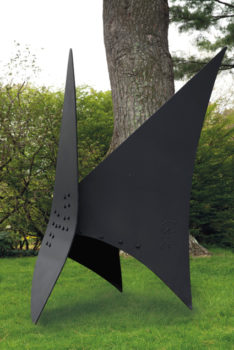
Alexander Calder, The Plow, 1967, sheet metal and paint, sold for $5.15 million.
CHRISTIE’S IMAGES LTD. 2018
A 1913 John Singer Sargent of the Grand Canal in Venice, with the San Geremia and the Palazzo Labia visible, painted in oil on his last visit to La Serenissima, flew past its $5 million high estimate to a $9.09 million finish, the third-highest price at auction for the painter. A Morris Graves once owned by Alfred Barr, the legendary founding director of the Museum of Modern Art in New York, sold for $408,500, more than quadrupling its high estimate of just $100,000. And a gimlet-eyed Precisionist rendering of Central Park from 1932 by Charles Sheeler dedicated to Abby Rockefeller blew past its $500,000 high estimate on its way to a $1.33 million finish.
(Unless noted, all reported prices include buyer’s premium, which is 25 percent of the hammer price up to and including $250,000, 20 percent of the hammer price from $250,000 up to and including $4 million, and then 12.5 percent for the lofty realm above that.
The top lot of the evening was a work that would typically be reserved for a sale of postwar and contemporary art—a late Willem de Kooning, Untitled XIX (1982), with ethereal waves of blue and red over white. It shot past its $8 million high estimate straight away, as a number of specialists on the telephone traded bids. Soon enough, mega-dealer Larry Gagosian, who represents the artist’s estate, was waving his right hand to bid, his left hand holding his phone to his ear.
The price on the de Kooning climbed by increments of $100,000, then sometimes by larger amounts. Gagosian went to $11.5 million, then $11.8 million, competing with the phones. “I’m happy to take as long as it needs,” Perrin said at one point. Gagosian went to $12.2 million, only to have a bid come in for $12.4 million by telephone. “We’re out,” he said, putting his phone down. It went for $14.3 million with premium, and he headed toward the door, along with numerous people in the saleroom.
Perrin kept up a steady, deliberate pace, and peppered the festivities with little quips—“I like a smile, a smile is good, I’ll take a bid,” she said at one point,” and when a hesitant bidder lifted his shoulders during the de Kooning, she said, “that might be an expensive shrug.”
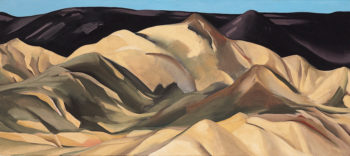
Georgia O’Keeffe, Near Abiquiu, New Mexico, 1931, oil on canvas, sold for $8.41 million.
CHRISTIE’S IMAGES LTD. 2018
Among other notable lots, an unusual Edward Hopper landscape without any buildings, Cape Ann Granite (1928), estimated at $6 million to $8 million, finished at $8.41 million, and a small Georgia O’Keeffe landscape, Near Abiquiu, New Mexico (1931), from her first trip to New Mexico, estimated at $3 million to $5 million, went for that same price went to a bidder in the room. (The majority of the works sold to the phones, as is often the case these days.) Alexander Calder’s The Plow, a six-foot-tall sculpture of swooping black forms commissioned by the Rockefellers in 1967 was estimated to sell for $2.5 million to $3.5 million but quickly passed that top figure as a handful of telephone bidders fought with a bidder in the room. It finally sold to Andy Massad of Christie’s for $5.15 million for a client on the phone.
The sale included four Milton Averys in quick succession—the artist most represented in the sale—and three of them jumped above their high estimate (perhaps the result of the rumor that a major museum is said to be organizing an Avery retrospective), with the tranquil beach scene White Umbrellas (1952) going for $1.87 million against a high estimate of just $700,000.
And the auction heralded another infrequent sight: a burst of excitement for the penultimate lot of the auction, with fierce bidding for a 1795 portrait of President George Washington by Gilbert Stuart. It had been estimated to sell for $1.2 million at most. It went much higher. The bids just kept coming! “$4 million in several places,” declared Perrin, as a number of bidders tried to offer that figure at one point. It climbed to $7.6 million, $7.7 million, and $7.8 million at a pace, then $8 million, going from there to $8.5 million when a telephone bidder pushed it to $9 million, competing with a lady in the room and earning gasps from the audience. When a telephone bidder asked to bid $9.95 million the room erupted in laughter. How high would it go?
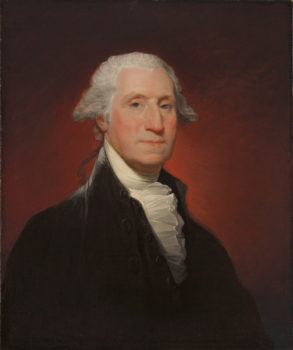
Gilbert Stuart, George Washington (Vaughan type), 1795, oil on canvas, sold for $11.6 million, an auction record for the artist.
CHRISTIE’S IMAGES LTD. 2018
Just one more bid it turned out. The lady in the room went to $10 million, and the bidding halted there. Perrin, finally getting a little rest, looked to her colleagues to ensure they were done. “Eric, why don’t you double-check it?” she said to Eric P. Widing, deputy chairman of American art, who was on the phone with a client. He shook his head. She brought her gavel down, selling the piece for $11.6 million with fees, a record for Stuart, who died 190 years ago.
Approached after the sale, the winner of the Washington declined to be interviewed. “I have so many non-disclosure agreements that I would be in jail before I got home if I told you my name,” she said dryly.
The final lot, a painting of Henry Hudson coming ashore by Robert Walter Weir sold with considerably less fanfare, for a below-estimate $200,000, and the last of the crowd exited.
The Rockefeller auctions continue tomorrow with day sales, and online sales conclude Friday. A number of pieces of jewelry will be offered at auction in June, when the final Rockefeller Collection sum is totaled but, already, last night, it had earned the distinction of being the largest single-owner sale ever held.
[ad_2]
Source link

